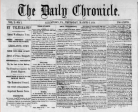St. James Gazette Review Was Published
20 Jun 1890
The St. James Gazette was a London evening newspaper published from 1880 to 1905, and it was founded out of the Pall Mall Gazette. The Pall Mall was—what we’d know as—radically right-winged, conservative, imperialism supporters, and extremely nationalist (Lee 165); their leadership was handed down to a few liberally left folk who intended to turn its image around to support liberalism, thus the St. James Gazette was born in order to keep their conservative views alive. The founder was Henry Hucks Gibbs (1819-1907), later to be named and ranked by his peers as Baron Aldenham, and he was a director of the Bank of England from 1853 to 1901 and its governor from 1875 to 1877. Aldenham was a huge part of the Conservative Party in Britain. The paper's first editor was Frederick Greenwood (1830-1909), who was the editor of the Pall Mall and had resigned immediately when the Pall Mall switched to liberal views. Greenwood stayed at the St. James Gazette until 1888, where he reigned and cemented their positions on nationalism; he was succeeded by Sidney Low (1857-1932), who was also conservative according to his obituary.
It was during Low’s editorship on June 20th, 1890, when the St. James Gazette published their review on The Picture of Dorian Gray. This reviewer did not enjoy the book at all, going at lengths to discredit the novelist’s motives, accomplishments, grammar, syntax, aspirations, and comprehension. They even tapped into their homophobia, which is how many of the readers reacted as well.
Associated Places
No places have been associated with this eventby vic peralta



